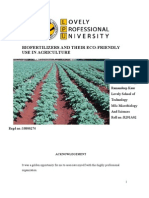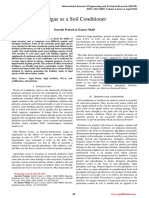Bio Fertilizers AGatewaytoSustainableAgriculture
Bio Fertilizers AGatewaytoSustainableAgriculture
Uploaded by
kom dehCopyright:
Available Formats
Bio Fertilizers AGatewaytoSustainableAgriculture
Bio Fertilizers AGatewaytoSustainableAgriculture
Uploaded by
kom dehOriginal Title
Copyright
Available Formats
Share this document
Did you find this document useful?
Is this content inappropriate?
Copyright:
Available Formats
Bio Fertilizers AGatewaytoSustainableAgriculture
Bio Fertilizers AGatewaytoSustainableAgriculture
Uploaded by
kom dehCopyright:
Available Formats
See discussions, stats, and author profiles for this publication at: https://www.researchgate.
net/publication/259717200
Bio-fertilizers- A Gateway to Sustainable Agriculture
Article · December 2013
CITATIONS READS
58 16,199
5 authors, including:
Balaram Mohapatra Deepak Kumar Verma
Indian Institute of Technology Bombay Indian Institute of Technology Kharagpur
60 PUBLICATIONS 866 CITATIONS 169 PUBLICATIONS 2,219 CITATIONS
SEE PROFILE SEE PROFILE
Anindita Sen Bipin Bihari Panda
ESR science and research ICAR - National Rice Research Institute, Cuttack, Odisha, India
9 PUBLICATIONS 94 CITATIONS 85 PUBLICATIONS 2,435 CITATIONS
SEE PROFILE SEE PROFILE
All content following this page was uploaded by Deepak Kumar Verma on 16 January 2014.
The user has requested enhancement of the downloaded file.
Issue
Popular Kheti Special
on
Volume -1, Issue-4 (October-December), 2013 Organic
Available online at www.popularkheti.info Farming
© 2013 popularkheti.info
ISSN:2321-0001 1(4) 2013
Bio-
Bio-fertilizers- A Gateway to Sustainable Agriculture
Balaram Mohapatra1*, Deepak Kumar Verma2, Anindita Sen3, Bipin Bihari Panda4 and Bavita Asthir5
1Environmental Molecular Microbiology Lab, Department of Biotechnology,
Indian Institute of Technology (IIT), Kharagpur (West-Bengal) -721302, India
2Department of Agricultural and Food Engineering,
Indian Institute of Technology (IIT), Kharagpur (West-Bengal) -721302, India
3Department of Biotechnology, Haldia Institute of Technology (HIT),
Haldia (West-Bengal) - 721651, India
4Department of Soil Science and Agronomy, Central Rice Research Institute (CRRI),
Cuttack (Odisha) -753006, India
5Department of Biochemistry, Punjab Agricultural University (PAU),
Ludhiana (Punjab) – 141004, India
*Email of corresponding author:
author: balarammohapatra09@gmail.com
Bio-fertilizers are one of the best modern tools and gift of our agricultural science as a
replacement to our conventional fertilizers. Conventional fertilizers contain compost;
household wastes and green manure and are not as effective as chemical fertilizers. So,
farmers often try to use chemical fertilizers in the field for crop development. But
obviously the chemical fertilizers are not environment friendly because of their
chemical toxicity that can cause water, air and soil pollution and can spread cancer
causing agents. Moreover, they may destroy the fertility of the soil in a long run.
Scientists have developed the way of organic farming by use of “Bio-fertilizers” to
prevent chemical pollution in farm lands. Bio-fertilizer contains microorganisms which
promote the adequate supply of nutrients to the host plants and ensure their proper
development of growth and regulation in their physiology. Living microorganisms are
used in the preparation of Bio-fertilizers which have specific functions to enhance
plant growth and reproduction. Bio-fertilizer being essential components of organic
farming play vital role in maintaining long term soil fertility and sustainability.
Introduction
In the past few decades, environmental pollution has become one of the world's major concerns,
as a number of toxic compounds, originating mostly from industrial and agricultural activities
which have effects of bioaccumulation and bio magnifications. Early detection and replacement of
Popular Kheti ISSN:2321-0001 97
Mohapatra et al (2013), Pop. Kheti, 1(4):97-106
toxic chemical compounds in the environment, particularly in water and soil and their biological
effects on organisms has therefore become increasingly important. Past trends in conventional
Indian agriculture, including monoculture without crop rotation, overuse of inorganic fertilizers,
and wide-scale applications of broad-spectrum organophosphate pesticides, have hindered the role
of naturally occurring microorganisms. Onset of green revolution and the increasing use of
chemical fertilizers in agriculture could make the country self-dependent in food production but
on the contrary it deteriorated the environment and caused harmful impacts on living beings. The
excess use of chemical fertilizers in agriculture is costly and also have various adverse effects on
soils i.e. depletes water holding capacity, soil fertility and disparity in soil nutrients. Hence, the
need to develop some low cost effective and eco-friendly fertilizers which would work without
disturbing the nature arose. Now, certain species of micro-organisms are being widely used which
have the unique ability to provide natural products that could serve as a good substitute for
chemical fertilizers.
What are Bio-
Bio-fertilizers?
A live formulation of micro-organisms (bacteria, fungi and algae) are used for fertilization of farm
lands in the aspect of fixation of N2, solubilization and mobilization of phosphorus, increasing
organic carbon content, balanced C/N ratio, plant growth promotion by increasing nutrient
absorption, antagonistic activity against plant pathogens, production of hormones etc that are
beneficial for agriculture. The Gazette of India (2006) defined bio-fertilizer as a product
containing carrier based (solid or liquid) living micro-organisms that are agriculturally useful in
terms of nitrogen fixation, phosphorous solubilization or nutrient mobilization. Bio-fertilizers
were promoted through integrated plant nutrient systems (IPNS) that involved combining
fertilizers, organic/green manures and bio-fertilizers to sustain crop production, maintaining soil
productivity, health and diversity.
Why Bio-
Bio-fertilizers?
As a safe alternative to chemical fertilizer, it minimizes the ecological disturbance and are cost
effective, eco-friendly and when they are required in bulk can be generated at the farm itself.
They increase crop yield upto 10-40% and fix nitrogen upto 40-50 Kg and parental inoculums are
sufficient for growth and multiplication of organisms in subsequent years. They improve soil
texture, pH, WHC and other properties of soil. They produce plant growth promoting substances
IAA, amino acids, vitamins etc. Bio-fertilizers contained 3.5% - 4% nitrogen, 2% - 2.5%
phosphorus and 1.5% potassium. In terms of N: P: K, it was found to be superior to farmyard
Popular Kheti ISSN:2321-0001 98
Mohapatra et al (2013), Pop. Kheti, 1(4):97-106
manure and other type of manure. Microbes (Table. 1) are effective in inducing plant growth,
enhance seed germination and root and shoot growth, decomposition of organic materials and
enrichment of compost.
Table. 1. Microbes used as Bio-
Bio-fertilizers
Groups Examples
N2 Fixing Bio
Bio--fertilizers
Free-living Beijerinkia, Azotobacter,Anabaena,Nostoc,
Symbiotic Rhizobium, Frankia,Anabaena azollae
Associative Symbiotic Azospirillum
P Solubilizing Bio-
Bio-fertilizers
Bacillus megaterium,Bacillus subtilis, Bacillus circulans,
Bacteria
Pseudomonas striata
Fungi Penicilliumspp, Aspergillusawamori
P Mobilizing Bio-
Bio-fertilizers
Arbuscularmycorrhiza Glomus spp., Gigaspora spp., Acaulospora spp.
Ectomycorrhiza Laccaria spp., Pisolithus sp., Boletus sp., Amanita spp.
Ericoid mycorrhizae Pezizellaericae
Orchid mycorrhiza Rhizoctoniasolani
Bio-
Bio-fertilizers for Micro nutrients
Silicate and Zinc solubilizers Bacillus spp.
Plant Growth Promoting Rhizobacteria
Pseudomonas Pseudomonas fluorescens
Source:http://www.agritech.tnau.ac.in/org_farm/orgfarm_biofertilizertechnology
Types of Bio-
Bio-fertilizers Available in Market
1. For Nitrogen:
1. Rhizobium for legume crops.
2. Azotobacter/Azospirillum for non-legume crops.
3. Blue Green Algae (BGA) and Azolla for low land paddy.
2. For Phosphorous:
1. Phosphatika for all crops to be applied with Rhizobium, Azotobacter, Azospirillum
and Acetobacter
3. For Enriched Compost:
1. Cellulolytic fungal culture
2. Phosphotika and Azotobacterculture
Popular Kheti ISSN:2321-0001 99
Mohapatra et al (2013), Pop. Kheti, 1(4):97-106
Microorganisms Used as Bio-
Bio-fertilizers
1. Nitrogen Fixing Bacteria
Rhizobia: Nitrogen, as a principal component of cell biomolecules (Amino acid, proteins,
enzymes), all plants need it as a sole source for their metabolism. Mostly leguminous plants
require high amount due to their protein demand and can’t fix atmospheric N2 due to high
energy expenditure. So, Legumes plants have root nodules, where atmospheric nitrogen fixation
is done by bacteria belonging to genera, Rhizobium, Bradyrhizobium, Sinorhizobium,
Azorhizobium and Mesorhizobium collectively called as rhizobia, belong to α-Proteobacteria.
When rhizobial culture is inoculated in field, pulse crops yield can be increased due to rhizobial
symbiosis (Dubey, 2001). Rhizobium can fix 15-20 N/ha and increase crop yield upto 20% in
pulses.
Table.2. Rhizobium-
Rhizobium-plant Associations
Rhizobium Host Plant
R. meliloti Medicago, Melilotus, Trigonellaspp.
R. leguminosarum
bv. Viciae Pisum, Vicia, Lathyrus, Lens spp.
bv. Trifolii Trifoliumspp.
bv. Phaseoli Phaseolus vulgaris
R. ciceri Cicerarietinum
R. tropici Phaseolus vulgaris, Leucaenaspp., Macroptiliumspp.
R. etli Phaseolus vulgaris
R. galegae Galegaofficinalis, G. Orientalis
R. fredii Glycine max, G. soja, and other legumes
B. japonicum Glycine max, G. soja, and other legumes
B. elkanii Glycine max, G. soja, and other legumes
A. caulinodans Sesbaniaspp. (stem nodulating)
Source: vanRhijnand Vanderleyden (1995)
Azorhizobium: It is a stem nodulating and nitrogen fixing symbionts of the stem nodule, it also
produce large amount of IAA that promotes plant growth.
Bradyrhizobium: Bradyrhizobium is a good nitrogen fixer. Bradyrhizobium strain inoculation
with Mucuna seeds enhances total organic carbon, N2, phosphorus and potassium in the soil,
increases plant growth and consequently plant biomass, reduction in the weed population and
increased soil microbial population.
Popular Kheti ISSN:2321-0001 100
Mohapatra et al (2013), Pop. Kheti, 1(4):97-106
2. Diazotrophs
Azotobacteracae (e.g. Azotobacter)
Azotobacter): They are the free living, non-symbiotic, aerobic,
photoautotrophic bacteria. They secretes vitamins, gibberellins, naphthalene, acetic acid and
other substances that inhibit certain root pathogens and improves root growth and uptake of
plant nutrients. It occurs in the roots of Paspalumnotatum (tropical grasses) and other spp. and
adds 15-93 Kg N/ha/annum on P. notatum roots. Azotobacter indicum occurs in acidic soil in
sugarcane plant roots. It can apply in cereals, millets, vegetables and flowers through seed,
seedlings soil treatment.
Spirillaceae (e.g. Azospirillum and Herbaspirillum)
Herbaspirillum): These are gram negative, free living,
associative symbiotic and non-nodule forming, aerobic bacteria, occurs in the roots of dicots and
monocot plants i.e. corn, sorghum, wheat etc. It is easy to culture and identify. Azospirillum is
found to be very effective in increasing 10-15% yield of cereal crops and fixes N2 upto 20-40%
Kg/ha. Different A. brasiliense strains inoculation in the wheat seed causes increase in seed
germination, plant growth, plumule and radicle length. Herbaspirillum species occurs in roots,
stems and leaves of sugarcane and rice. They produce growth promoters (IAA, Gibberillins,
Cytokinins) and enhance root development and uptake of plant nutrients (N, P & K).
Acetobacterdiazotrophicus: Another diazotroph is Acetobacterdiazotrophicus occurs in roots,
stem and leaves of sugarcane and sugar beet crops as nitrogen fixer and applied through soil
treatment. It also produces growth promoters e.g. IAA and helps in nutrients uptake, seed
germination, and root growth. This bacterium fixes nitrogen upto 15kg /ha/year and enhance
upto 0.5 – 1% crop yield (Gahukar, 2005-06).
Cyanobacteria (Blue green algae): Nostoc, Anabaena, Oscillatoria, Aulosira, Lyngbya etc. are the
prokaryotic organisms and phototropic in nature. They play an important role in enriching paddy
field soil by fixing atmospheric nitrogen and supply vitamin B complex and growth promoting
substance which makes the plant grow vigorously. Cyanobacteria fixes 20-30 Kg/N/ha and
increase 10-15% crop yield when applied at 10 Kg/ha. Both free-living as well as symbiotic
cyanobacteria (blue green algae) used in rice cultivation in India.
Azolla – Anabaena symbiosis:
symbiosis: It is a free floating, aquatic fern found on water surface having a
cyanobacterial symbiont Anabaena azollae in their leaves. It fixes atmospheric nitrogen in paddy
field and excrete organic nitrogen in water during its growth and also immediately upon
trampling. Azolla contributes nitrogen, phosphorus (15-20 Kg/ha/month), potassium (20-25
kg/ha/month) and organic carbon etc. and increases 10-20% yield of paddy crops and also
suppresses weed growth. Azolla also absorbs traces of potassium from irrigation water and can be
Popular Kheti ISSN:2321-0001 101
Mohapatra et al (2013), Pop. Kheti, 1(4):97-106
used as green manure before rice planting. Azolla spp. are metal tolerant hence, can be applied
near heavy metal polluted areas.
3. Phosphate Solubilising Bacteria:
Bacteria: Solubilization of inorganic tricalcium and rock phosphate
occurs by most of bacteria belong to genus: Pseudomonas, Bacillus, Acrobacter, Nitrobacter,
Escherichia, Serratia spp. and speciallyPseudomonas striata, Bacillus polymyxa are the bacteria
have phosphate solubilising ability. ‘Phosphobacterin’ are the bacterial fertilizers containing cells
of Bacillus megatherium var. phosphaticum, prepared firstly by USSR scientists. They increased
about 10 to 20 % crop yield and also produces plant growth promoting hormones which helps in
phosphate solubilising activity of soil.
4. Phosphate Solubilizing Fungi:
Fungi: Some fungi also have phosphate dissolving ability e.g.
Aspergillus niger, Aspergillus awamori, Penicillium digitatum etc. All the microbes solubilize
phosphate by production of organic acids.
5. Silicate Solubilizing Bacteria:
Bacteria: Microorganisms are capable of degrading silicates and aluminum
silicates. During the metabolism of microbes several organic acids are produced and these have a
dual role in silicate weathering. They supply H+ ions to the medium and promote hydrolysis and
the organic acids like citric, oxalic acid, Keto acids and hydroxy carbolic acids which from
complexes with cations, promote their removal and retention in the medium in a dissolved state.
Most of soil born Bacillus spp. can be used as silicates solubilizers.
6: Plant Growth Promoting Rhizobacteria (PGPR):
(PGPR): The group of bacteria that colonize roots or
rhizosphere soil and beneficial to crops are referred to as plant growth promoting rhizobacteria
(PGPR). They are also called as microbial pesticides e.g. Bacillus spp. and Pseudomonas
fluorescence. Serratia spp. and Ochrobactrum spp. are able to promote growth of plants. The
PGPR inoculants currently commercialized that seem to promote growth through at least one
mechanism; suppression of plant disease (termed Bio-protectants), improved nutrient acquisition
(termed Bio-fertilizers), or phyto-hormone production (termed Bio-stimulants). Species
of Pseudomonas and Bacillus can produce as yet not well characterized phyto-hormones or
growth regulators that cause crops to have greater amounts of fine roots which have the effect of
increasing the absorptive surface of plant roots for uptake of water and nutrients. These PGPR
are referred to as Bio-stimulants and the phyto-hormones they produce include indole-acetic
acid, cytokinins, gibberellins and inhibitors of ethylene production.
7. Mycorrhiza:
Mycorrhiza: Mycorrhizas are symbiosis between some specific root inhabiting fungi and plant
roots and used as Bio-fertilizers. They absorb nutrients such as manganese, phosphorus, iron,
Popular Kheti ISSN:2321-0001 102
Mohapatra et al (2013), Pop. Kheti, 1(4):97-106
sulphur, zinc etc. from the soil and pass it to the plant. Mycorrhizal fungus increases the yield of
crops by 30-40% and also produces plant growth promoting substances.
8. VAM fungi or Endomycorrhiza:
Endomycorrhiza: They form arbuscles in the roots of crop plants and enhance
nutrient uptake: phosphorus and other nutrients that are responsible for plant growth
stimulation including roots and shoot length. VAM also enhances the growth of black pepper and
protects from Phytophthora capsici, Radopholus similis and Melvidogyne incognita (Anandraj et
al., 2001). VAM fungi enhance water uptake in plants and also provide heavy metals tolerance to
plants..
Application of Bio-
Bio-fertilizers
Seed treatment:
treatment: One packet of the inoculants (200 g) is mixed with 200 ml of rice kanji to make
slurry. The seeds required for an acre are mixed in the slurry so as to have a uniform coating of
the inoculant over the seeds and then shade dried for 30 minutes. The shade dried seeds should
be sown within 24 hours. One packet of the inoculant (200 g) is sufficient to treat 10 kg of seeds.
Seedling root Dip:
Dip: It has better application for transplanted crops. Two packets of the inoculant
is mixed in 40 liters of water. The root portion of the seedlings required for an acre is dipped in
the mixture for 5 to 10 minutes and then transplanted.
Main field application:
application: 1kg of the inoculant is mixed with 20 kg of dried and powdered farm yard
manure and then broadcasted in one acre of main field just before transplanting.
Mass Production of Bio-
Bio-fertilizers
The mass production of Bio-fertilizers involves three stages:
Stage-
Stage-1: Culturing of microorganisms
Stage-
Stage-2: Processing of carrier material
Stage-
Stage-3: Mixing the carrier and the broth culture and packing
Bio-fertilizers are carrier based preparations containing efficient strain of nitrogen fixing or
phosphate solubilizing microorganism prepared in suitable medium and mass produced in
fermentor with proper aeration, temperature, growth conditions and without any undesired
microbial contaminations. Bio-fertilizers are formulated usually as carrier based inoculants. The
organic carrier materials are more effective for the preparation of bacterial inoculants. Peat soil,
lignite, vermiculite, charcoal, press mud, farmyard manure and soil mixture can be used as carrier
materials. The neutralized peat soil/lignite are found to be better carrier materials for bio-
fertilizer production which is cheaper, locally available, inert, having high WHC and organic
content. The bacterial culture drawn from the fermentor is added to the sterilized carrier and
mixed well by manual (by wearing sterile gloves) or by mechanical mixer then sealed at room
temperature.
Popular Kheti ISSN:2321-0001 103
Mohapatra et al (2013), Pop. Kheti, 1(4):97-106
Table 3. Microorganisms as Bio-
Bio-fertilizers for
for different crops
Microorganism Nutrient fixed Host Crops for
(Kg/ha/year)1 which Used
Actinorrhizae 150 kg N/ha For certain non-legumes mainly
(Frankia spp.) trees & Shrubs
Algae 25 kg N/ha Rice
Azolla 900 kg N/ha Rice
Azospirillum 50 to 300 kg N/ ha Non-legumes like maize, barley,
oats, sorghum, millets sugarcane,
rice etc
Rhizobium 0.026 to 20 kg N / ha Legumes like pulses, peas,
Groundnut, soybean, beans, and
clover
Azotobacter 10-20 kg N /ha Cereals, millets, cotton, vegetables
Mycorrhizae (VAM) Solubilize food phosphorus (60%) Many tree species, wheat, sorghum,
ornamentals
Phosphate solubilizing Solubilize about 50-60% of them Soil application for all crops
Bacteria and fungi fixed phosphorus in the soil
Sources: Mall et al., (2013)
Table.4. Recommended liquid bio- bio-fertilizers and its application method, quantity to be used for
different crops are as follows:
follows
Recommended Application Quantity to be
Bio-
Bio-fertilizer method used Crops
Rhizobium Seed treatment 200ml/acre Chickpea, pea, Groundnut,
soybean, beans, Lentil, Green
gram, Black gram, Cowpea and
pigeon pea
Azotobacter/Azospirillum Seed treatment 200ml/acre Wheat, oat, barley
Azospirillum Seed treatment 200ml/acre Rice
Azotobacter Seed treatment 200ml/acre Mustard, seasum, Linseeds,
Sunflower, castor
Azotobacter Seed treatment 200ml/acre Pearl millets, Finger millets, kodo
millet
Azospirillum Seed treatment 200ml/acre Maize and Sorghum
Azotobacter Seed treatment 200ml/acre Forage crops and Grasses
Azotobacter Soil treatment 400ml/acre Tea, Coffee
Azotobacter Soil treatment 2-3 ml/plant Rubber, Coconuts
Rhizobium Soil treatment 1-2 ml/plant Leguminous plants/ trees
Note: Doses recommended when count of inoculum is 1 x 108 cells/ml then doses will be ten times more besides
above said Nitrogen fixers, Phosphate solubilizers and potash mobilizers at the rate of 200 ml/ acre could be applied
for all crops.
Popular Kheti ISSN:2321-0001 105
Mohapatra et al (2013), Pop. Kheti, 1(4):97-106
Storage of Bio-
Bio-Fertilizer Packets
• The packet should be stored in a cool place away from the heat or direct sunlight.
• The packets may be stored at room temperature or in cold storage conditions in lots in
polythene /gunny bags.
• The population of inoculant in the carrier inoculant packet may be determined at 15 days
interval. There should be more than 109 cells / g of inoculant at the time of preparation.
Constraints in Bio-
Bio-fertilizer Technology
In spite of low cost, eco-friendliness, several constraints limit the application or implementation
of the technology. The constraints may be environmental, technological, infrastructural,
financial, human resources, unawareness, quality, marketing, etc.
Technological constraints:
onstraints: Use of improper, less efficient strains for production, lack of qualified
technical personnel, good quality carrier material, production of poor quality inoculants without
understanding the basic microbiological techniques and short shelf life of inoculants.
Infrastructural constraints:
onstraints: Lack of essential equipments, non-availability of suitable facilities for
production, space availability for laboratory, production, storage etc.
Financial constraints:
onstraints: Non-availability of sufficient funds and problems in getting bank loans and
less return by sale of products in smaller production units.
Environmental
Environmental constraints:
onstraints: Seasonal demand for Bio-fertilizers, simultaneous cropping
operations and short span of sowing/planting in a particular locality, soil characteristics like
salinity, acidity, drought, water logging, etc.
Conclusion
As a boon for farmers, Bio-fertilizers being essential components of organic farming play vital
role in maintaining long term soil fertility and sustainability. Bio-fertilizers would be the viable
option for farmers to increase productivity per unit area in organic farming for an era of
prosperity and clean environment.
References
Anandraj M, Venugopal MN, Veena SS, Kumar A and Sarma YR. 2001.Ecofriendly management of
disease of species.Indian species. 38 (3): 28-31.
Dubey RC. 2001. A text book of biotechnology. S. Chand & Company Ltd. New Delhi.
Gahukar RT 2005-06. Potential and use of bio-fertilizers in India.Evermans science. XL (5): 354-361.
Mall RK, Verma DK, Tripathi HC, Pathak RK and Asthir B. 2013. Bio-fertilizers in Context of
Farmers and Agriculture in India.Indian Farmer’s Digest.46 (1): 16-18.
vanRhijn P and Vanderleyden J. 1995. The Rhizobium-Plant Symbiosis.Microbiology Review.59 (1):
124–142.
Popular Kheti ISSN:2321-0001 106
View publication stats
You might also like
- Graphic Designing Course OutlineDocument4 pagesGraphic Designing Course OutlineB pradhan100% (2)
- Task 53-00-14-300-002Document5 pagesTask 53-00-14-300-002mashobih hussururNo ratings yet
- Occt 651 - Occupational Profile and Intervention PlanDocument22 pagesOcct 651 - Occupational Profile and Intervention Planapi-279916752No ratings yet
- Bio FertilizersforOrganicAgricultureDocument7 pagesBio FertilizersforOrganicAgriculturenimra imtiazNo ratings yet
- BiofertilizersAnoveltoolforagriculture1 2 6 IJMRDocument10 pagesBiofertilizersAnoveltoolforagriculture1 2 6 IJMRSantosh SongalNo ratings yet
- PJA31Document20 pagesPJA31Rodrigo Alejandro Romo MuñozNo ratings yet
- Biofertilizer As A Supplement of Chemical Fertilizer For Yield Maximization of - Naher Et Al 2016Document8 pagesBiofertilizer As A Supplement of Chemical Fertilizer For Yield Maximization of - Naher Et Al 2016Leo InocencioNo ratings yet
- PookaDocument13 pagesPookavedatac951No ratings yet
- BIO-FERTILIZER FROM GENETICALLY MODIFIED MICROBIAL CONSORTIUM"gDocument44 pagesBIO-FERTILIZER FROM GENETICALLY MODIFIED MICROBIAL CONSORTIUM"gAshok KumarNo ratings yet
- Role of Fertilizers in AgricultureDocument5 pagesRole of Fertilizers in AgricultureItalominatorNo ratings yet
- Agriculture 13 00417Document15 pagesAgriculture 13 00417swetharaghu4311No ratings yet
- Biofertilizers - A Way To Organic AgricultureDocument4 pagesBiofertilizers - A Way To Organic AgricultureJesus DurangoNo ratings yet
- Production and Characterization of Bio Fertilizer From Potato Peel IJERTV13IS020123Document12 pagesProduction and Characterization of Bio Fertilizer From Potato Peel IJERTV13IS020123angelgelmayNo ratings yet
- Cow Urine A Boon For Sustainable AgricultureDocument7 pagesCow Urine A Boon For Sustainable AgricultureperfectstatisticsNo ratings yet
- 265 (1)Document9 pages265 (1)fathi kyutiNo ratings yet
- Biofertilizers and Their Eco-Friendly Use in AgricultureDocument12 pagesBiofertilizers and Their Eco-Friendly Use in AgricultureRishi SharmaNo ratings yet
- Pojekt 2Document12 pagesPojekt 2Pasal BazaarNo ratings yet
- Kajian Proses Produksi Pupuk Hayati Bio-Srf Dan Pengujian Efektivitasnya Pada Tanaman Bawang MerahDocument10 pagesKajian Proses Produksi Pupuk Hayati Bio-Srf Dan Pengujian Efektivitasnya Pada Tanaman Bawang Merahrama firmaretaNo ratings yet
- FFTC Document Database: Site Search SearchDocument11 pagesFFTC Document Database: Site Search SearchaiktiplarNo ratings yet
- V7I1002Document6 pagesV7I1002neerajkumar07111994No ratings yet
- International Journalof Recyclingof Organic Wastein AgricultureDocument12 pagesInternational Journalof Recyclingof Organic Wastein Agriculturerodenfrnndz24No ratings yet
- Bio-Enhancers: A Potential Tool To Improve Soil Fertility and Plant Health in Organic Production of Horticultural CropsDocument19 pagesBio-Enhancers: A Potential Tool To Improve Soil Fertility and Plant Health in Organic Production of Horticultural CropsAzizrahman AbubakarNo ratings yet
- KCSR ChemistryDocument9 pagesKCSR Chemistryyarmy100No ratings yet
- Production of Organic Manure From Kitchen Waste: Ensuring Livelihood of Resource Poor WomenDocument4 pagesProduction of Organic Manure From Kitchen Waste: Ensuring Livelihood of Resource Poor WomenPatel Kartavya03No ratings yet
- The Impact of Chemical Fertilizers On Our Environment and EcosystemDocument19 pagesThe Impact of Chemical Fertilizers On Our Environment and EcosystemDiana DainaNo ratings yet
- Application of Different Fertilizer Types and Levels On Vegetable Production A Critical ReviewDocument8 pagesApplication of Different Fertilizer Types and Levels On Vegetable Production A Critical ReviewAITHESSWARY A/P JAMES STUDENTNo ratings yet
- 2020 (Application of Different Fertilizer Types and Levels On Vegetable Production A Critical Review)Document8 pages2020 (Application of Different Fertilizer Types and Levels On Vegetable Production A Critical Review)hamzashahid01No ratings yet
- SimpleBioinoculantmultiplication IJAS 2019Document6 pagesSimpleBioinoculantmultiplication IJAS 2019Ian RamelanNo ratings yet
- Importance Prospects and Constraints of Organic Farming in IndiaDocument7 pagesImportance Prospects and Constraints of Organic Farming in IndiaGudduNo ratings yet
- Conversion of Fish Wastes Into Liquid Fertilizer by Using Microbes For Sustainable Organic AgricultureDocument2 pagesConversion of Fish Wastes Into Liquid Fertilizer by Using Microbes For Sustainable Organic AgricultureGino RaNo ratings yet
- Reviewpaper 2Document9 pagesReviewpaper 2Rodrigo Alejandro Romo MuñozNo ratings yet
- Rahul Mini Project 2023Document35 pagesRahul Mini Project 2023VIVEKANAND MISHRANo ratings yet
- 2015 WJPRDocument17 pages2015 WJPRchizobaNo ratings yet
- Algae As A Soil Conditioner: Saurabh Prakash & Kumar NikhilDocument3 pagesAlgae As A Soil Conditioner: Saurabh Prakash & Kumar NikhilerpublicationNo ratings yet
- OrganicFarmingCh2 PDFDocument15 pagesOrganicFarmingCh2 PDFHel BaldioNo ratings yet
- Application of Biofertilizers in Crop Production: A ReviewDocument19 pagesApplication of Biofertilizers in Crop Production: A ReviewDr Arunprasath ANo ratings yet
- Wa0012.Document7 pagesWa0012.rahul vermaNo ratings yet
- Azotobacter: A Complete Review: Conference PaperDocument9 pagesAzotobacter: A Complete Review: Conference PaperNamrata ChaudhariNo ratings yet
- Bio-Fertilizer Possibilities and Scope in NepalA ReviewDocument5 pagesBio-Fertilizer Possibilities and Scope in NepalA ReviewInternational Journal of Innovative Science and Research TechnologyNo ratings yet
- SaranDocument18 pagesSaranᏕᴀᴋᴛʜɪ ᏕᴘᴏᴛᴜNo ratings yet
- Composition, Manufacture and Application Procedures For Compost, Vermicompost and Vermiwash in The Development of Organic Crop ProductionDocument5 pagesComposition, Manufacture and Application Procedures For Compost, Vermicompost and Vermiwash in The Development of Organic Crop ProductionIJAR JOURNALNo ratings yet
- BiofertilizersDocument8 pagesBiofertilizersUmer FarooqNo ratings yet
- Microbial Biofertilizers: Bioresources and Eco-Friendly Technologies For Agricultural and Environmental SustainabilityDocument12 pagesMicrobial Biofertilizers: Bioresources and Eco-Friendly Technologies For Agricultural and Environmental SustainabilityNELIDA FUSTAMANTE CABRERANo ratings yet
- Bio-Efficacy of Cow Urine On Crop Production: A Review: ArticleDocument5 pagesBio-Efficacy of Cow Urine On Crop Production: A Review: Articleimroatun mashluhahNo ratings yet
- Production of Biofertilizers From Agro-Wastes: November 2018Document15 pagesProduction of Biofertilizers From Agro-Wastes: November 2018Abdullahi Tahiru SarajoNo ratings yet
- Seaweed Fertilizers in Modern Agriculture: October 2018Document8 pagesSeaweed Fertilizers in Modern Agriculture: October 2018JELICEL ATENo ratings yet
- Guisadiooutline 1Document37 pagesGuisadiooutline 1madel.guisadio12No ratings yet
- NR 07 01 04 Patgiri Swami Yumnam m00376Document15 pagesNR 07 01 04 Patgiri Swami Yumnam m00376mindowaretoolsNo ratings yet
- Amino Chelate Fertilizers As The Latest Novelties in Plant Nutrition A ReviewDocument4 pagesAmino Chelate Fertilizers As The Latest Novelties in Plant Nutrition A ReviewEditor IJTSRDNo ratings yet
- Organic Agriculture: Biofertilizer - A ReviewDocument5 pagesOrganic Agriculture: Biofertilizer - A ReviewLeny Brilyan ANo ratings yet
- Effects of Algal Bio-Fertilizer On The Growth Of: Vigna RadiataDocument5 pagesEffects of Algal Bio-Fertilizer On The Growth Of: Vigna RadiataerpublicationNo ratings yet
- 14 Bacterial Inoculant-1Document1 page14 Bacterial Inoculant-1RAJESH KUMARNo ratings yet
- Ijsrp p3818 PDFDocument4 pagesIjsrp p3818 PDFAndres BrutasNo ratings yet
- DR Peera - RIC Meeting PresentationDocument16 pagesDR Peera - RIC Meeting Presentationmbabunspr9No ratings yet
- Biofertilizers PDFDocument18 pagesBiofertilizers PDFAmeet Kudche100% (1)
- Development of Production Technology for Preparati (2)Document10 pagesDevelopment of Production Technology for Preparati (2)Md. BadrulNo ratings yet
- Biofertilizer For Bioremediation: January 2015Document31 pagesBiofertilizer For Bioremediation: January 2015Ahmad FarhanNo ratings yet
- 1 en 1 Chapter AuthorDocument23 pages1 en 1 Chapter AuthorDung NguyenNo ratings yet
- The Comparative Study of Biofertilizers On Growth and Yield of Wheat: A ReviewDocument6 pagesThe Comparative Study of Biofertilizers On Growth and Yield of Wheat: A ReviewInternational Journal of Innovative Science and Research Technology100% (1)
- Production Technology of Drumstick: (Moringa oleifera Lam.)From EverandProduction Technology of Drumstick: (Moringa oleifera Lam.)No ratings yet
- Compendium on Micronutrient Fertilisers in India Crop Response & Impact, Recent Advances and Industry TrendsFrom EverandCompendium on Micronutrient Fertilisers in India Crop Response & Impact, Recent Advances and Industry TrendsNo ratings yet
- Bokashi Composting: Kitchen Scraps to Black Gold in 2 Weeks: Black Gold Organic Gardening, #2From EverandBokashi Composting: Kitchen Scraps to Black Gold in 2 Weeks: Black Gold Organic Gardening, #2Rating: 4.5 out of 5 stars4.5/5 (2)
- Al-Kitaab Study Guide and Activities - Lesson-1Document2 pagesAl-Kitaab Study Guide and Activities - Lesson-1Lawrence 'Lorenzo' AzureNo ratings yet
- Department of Education: Science 7Document5 pagesDepartment of Education: Science 7Maria Novy PintoNo ratings yet
- Festive Launches - WiZ Connected - Smart HomesDocument5 pagesFestive Launches - WiZ Connected - Smart Homespistolfire99No ratings yet
- Bản PDF 400 Câu Phát Âm Tiếng Anh Cực Hay Giúp Bạn Ôn Luyện Thi Thpt Quốc Gia Dễ DàngDocument3 pagesBản PDF 400 Câu Phát Âm Tiếng Anh Cực Hay Giúp Bạn Ôn Luyện Thi Thpt Quốc Gia Dễ DàngMỹ Lệ Trịnh ThịNo ratings yet
- Appendix 02 - List of Deliverables PDFDocument32 pagesAppendix 02 - List of Deliverables PDFshareyhouNo ratings yet
- Projector Printer PDFDocument2 pagesProjector Printer PDFGe PebresNo ratings yet
- Student Guide - PregradDocument11 pagesStudent Guide - PregradSarthakNo ratings yet
- F CF Rca23Document12 pagesF CF Rca23Adam JonesNo ratings yet
- Dissertation of PracticeDocument5 pagesDissertation of PracticeWhatShouldIWriteMyPaperOnCincinnati100% (1)
- Risk Assessment Form: Section A: Activity DetailsDocument3 pagesRisk Assessment Form: Section A: Activity DetailsJOAQUINFERNADO SANCHEZNo ratings yet
- Coefficient For Negative Moments in Slab (W Total DL + LL)Document3 pagesCoefficient For Negative Moments in Slab (W Total DL + LL)Kim Limuel Tabago GomezNo ratings yet
- Menu Design and EngineeringDocument366 pagesMenu Design and EngineeringHafiz Adha100% (3)
- Connections Remembered, Forgotten and NeglectedDocument4 pagesConnections Remembered, Forgotten and NeglectedNorm FriesenNo ratings yet
- Ejercicios PinskyDocument66 pagesEjercicios PinskyA KarenMartz HerdezNo ratings yet
- Introduction To Nouns and PronounsDocument10 pagesIntroduction To Nouns and PronounsmikayhistoriaNo ratings yet
- Positive & Safe Isolation MethodDocument118 pagesPositive & Safe Isolation MethodRahul S. Chandrawar100% (1)
- Why Does Milk Curdle?: AnswerDocument3 pagesWhy Does Milk Curdle?: AnswerderdorNo ratings yet
- Ethics and Moral Philosophy - General Introduction - 2020 - Lecture 1Document3 pagesEthics and Moral Philosophy - General Introduction - 2020 - Lecture 1BlueBladeNo ratings yet
- Brain-Based Computer Interfaces in Virtual RealityDocument6 pagesBrain-Based Computer Interfaces in Virtual RealityJorge HernándezNo ratings yet
- Development and Maintenance of Standards and Accreditation ofDocument38 pagesDevelopment and Maintenance of Standards and Accreditation ofsrimalathi100% (1)
- Solution Manual Chap 8Document5 pagesSolution Manual Chap 8sshahar2No ratings yet
- Francois Quesnay Economics PresentationDocument5 pagesFrancois Quesnay Economics PresentationSpider ManNo ratings yet
- Franchising USA - May 2020 PDFDocument58 pagesFranchising USA - May 2020 PDFAzizNo ratings yet
- SP-2065 2012 Document Management For ProjectsDocument28 pagesSP-2065 2012 Document Management For ProjectsnickchoNo ratings yet
- Project Risk Management 2016Document55 pagesProject Risk Management 2016Imam Caksate100% (1)
- Ge, Mo Lin He, Yang Hui YangDocument231 pagesGe, Mo Lin He, Yang Hui YangGustavo VillarNo ratings yet
- CM Strat YipDocument9 pagesCM Strat Yipmeherey2kNo ratings yet

























































































